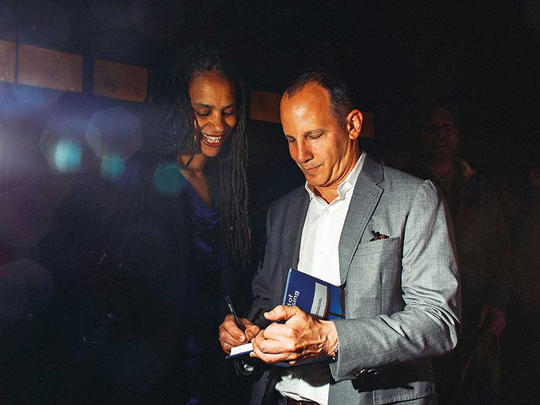
New York
New York media types aren’t quick to pass up a party, even one celebrating a book that predicts their demise.
So it was that several guests who work in advertising were at the Greenwich Hotel in Tribeca, where the beverages and old-fashioneds flowed freely and a new book called “The End of Advertising” and its author, Andrew Essex, were being saluted. Essex, chief executive of Tribeca Enterprises, the firm behind the Tribeca Film Festival, is a relatively recent defector from the ad world, where he was a co-founder and chief executive of the agency Droga5.
The fete was hosted by Jane Rosenthal, a movie producer who founded the Tribeca Film Festival with Robert De Niro and Craig Hatkoff and is now executive chairwoman of Tribeca Enterprises. After Rosenthal offered a toast to Essex, he took the opportunity to offer a caveat.
“The title of the book is not particularly imaginative but really should be ‘The End of Bad Advertising,’” Essex said. “I did want to say that for several people here who make their living from it.” “It’s not all over. It’s just over for people who are producing” bad stuff, he said, using a more profane term.
But his outlook for Madison Avenue is not sunny. Essex did not leave advertising so much as flee it, as per his new book. He described his discovery and subsequent enchantment with ad-blocking software and criticised most advertising, including television commercials, as being annoying, excessive and lacking creativity.
The future of marketing will need to rely on creative, innovative models, Essex wrote, pointing to “The Lego Movie” and New York’s Citi Bike bicycle-share programme as promising examples. For the past two years, in fact, the Tribeca Film Festival has handed out an award for the best “storytelling” by brands working with artists and filmmakers.
Those mixing in the hotel’s chic, library-like atmosphere seemed to be latching on to the message that creativity would win the day. Rather than the feeling of impending doom, one marketing executive from Bank of America said it was a thrilling time to be working in the industry, with the shifts in the way ads reach the public forcing innovation.
Others echoed that sentiment. While traditional ways of reaching consumers may be changing, it is in fact the “golden age of marketing,” said Scott Kauffman, chief executive of MDC Partners, which owns agencies like 72andSunny. He was also sceptical of the premise that people loathe ads, saying, “Ask a Harley-Davidson aficionado if they’re annoyed by Harley-Davidson ads.”
Essex himself remains an ardent admirer of Droga5. It is behind a wide range of notable video campaigns, including Under Armour’s with dancer Misty Copeland and Anna Kendrick’s almost-Super Bowl commercial for Newcastle Brown Ale.
Still, even those whose contact with the advertising world is mainly fictional can sense the challenges the industry faces. Actor John Slattery, best known for playing ad executive Roger Sterling in the series “Mad Men”, emerged as a surprise guest at the event, courtesy of Rosenthal.
Slattery said he was about halfway through Essex’s book. Advertising is a difficult business today, he said, with the advent of platforms like Facebook and Google.
“How do you get seen in all the noise?” he asked. Or, as Essex put it in his book: “When traditional advertising was first invented, there were 16 or so waking hours in a day. That baseline hasn’t changed, but the number of things frenetically competing for our attention at any given moment has, we all know, increased exponentially.”
Reading the book has paid off for Slattery. “I didn’t know about ad-blocking, period, and downloaded it,” he said, marvelling at the software, of which he is now a fan.
When asked whether he watched TV commercials, he shook his head no. The effectiveness of the tried-and-true 30-second spot is a timely topic, given that the upfront presentations, when TV networks try to entice ad buyers into backing their fall line-ups, recently concluded. When asked whether the 30-second TV commercial was dying, Catharine Hays, who directs the Future of Advertising programme at the University of Pennsylvania’s Wharton School, said that was “the wrong question”.
The right question, she said, is “What’s better than the 30-second ad?”
According to Essex’s book, airline terminals. “What if brands looked to infrastructure as the new official canvas for their commercials?” he wrote. “Imagine a Pfizer-branded ferry. An entire airline terminal brought to you by Citibank, rather than filled with random spots and dots. A new light-rail line with pleasing colours and comfortable seats, rather than our horrific commuter train system.”
Bill Derrough, the restructuring expert who recently became the Democratic National Committee’s treasurer, was also in attendance. Could the broader industry shifts change spending on political ads in the future?
“Ask me again after I’ve raised some money,” Derrough said with a smile.
— New York Times News Service











